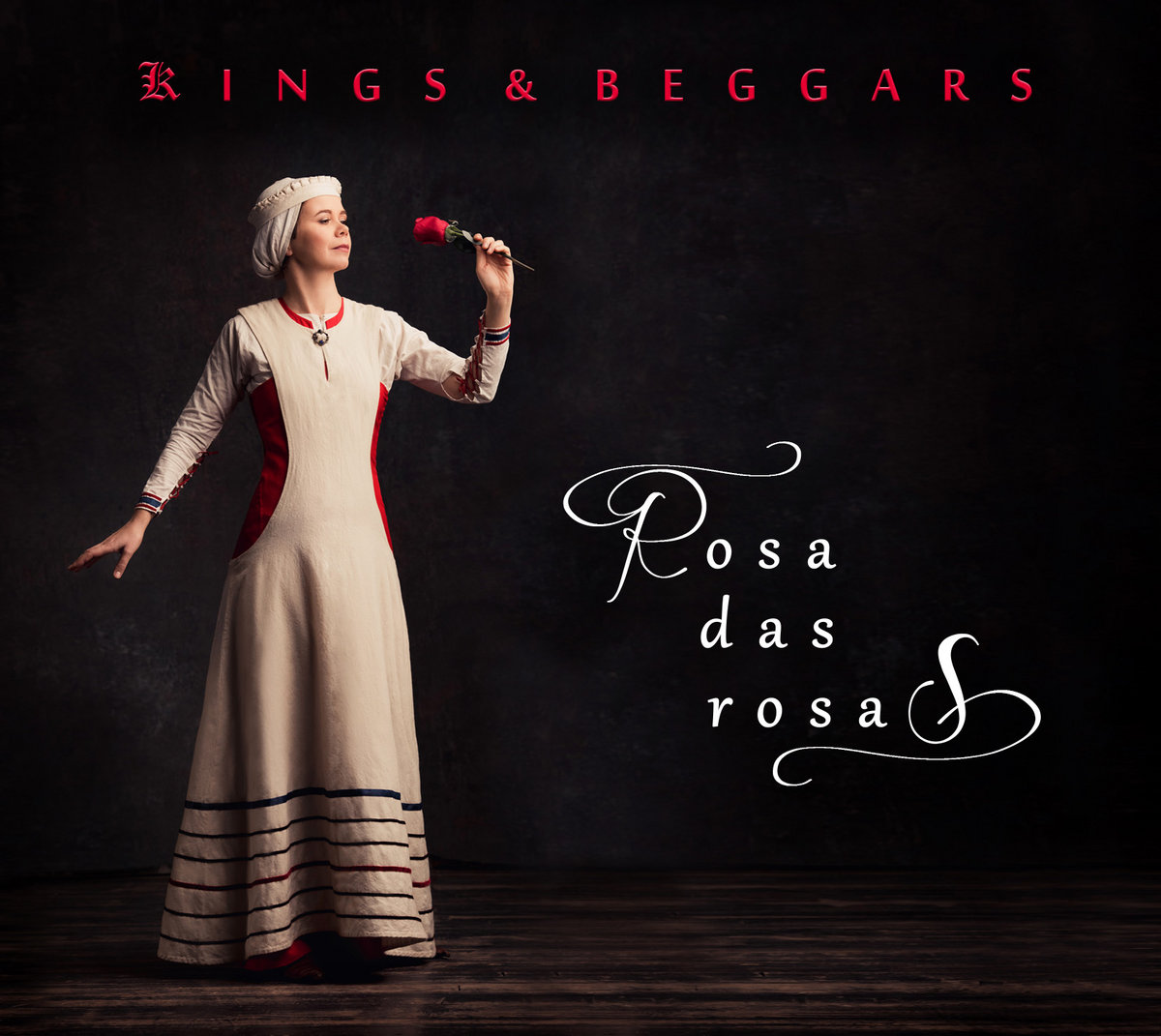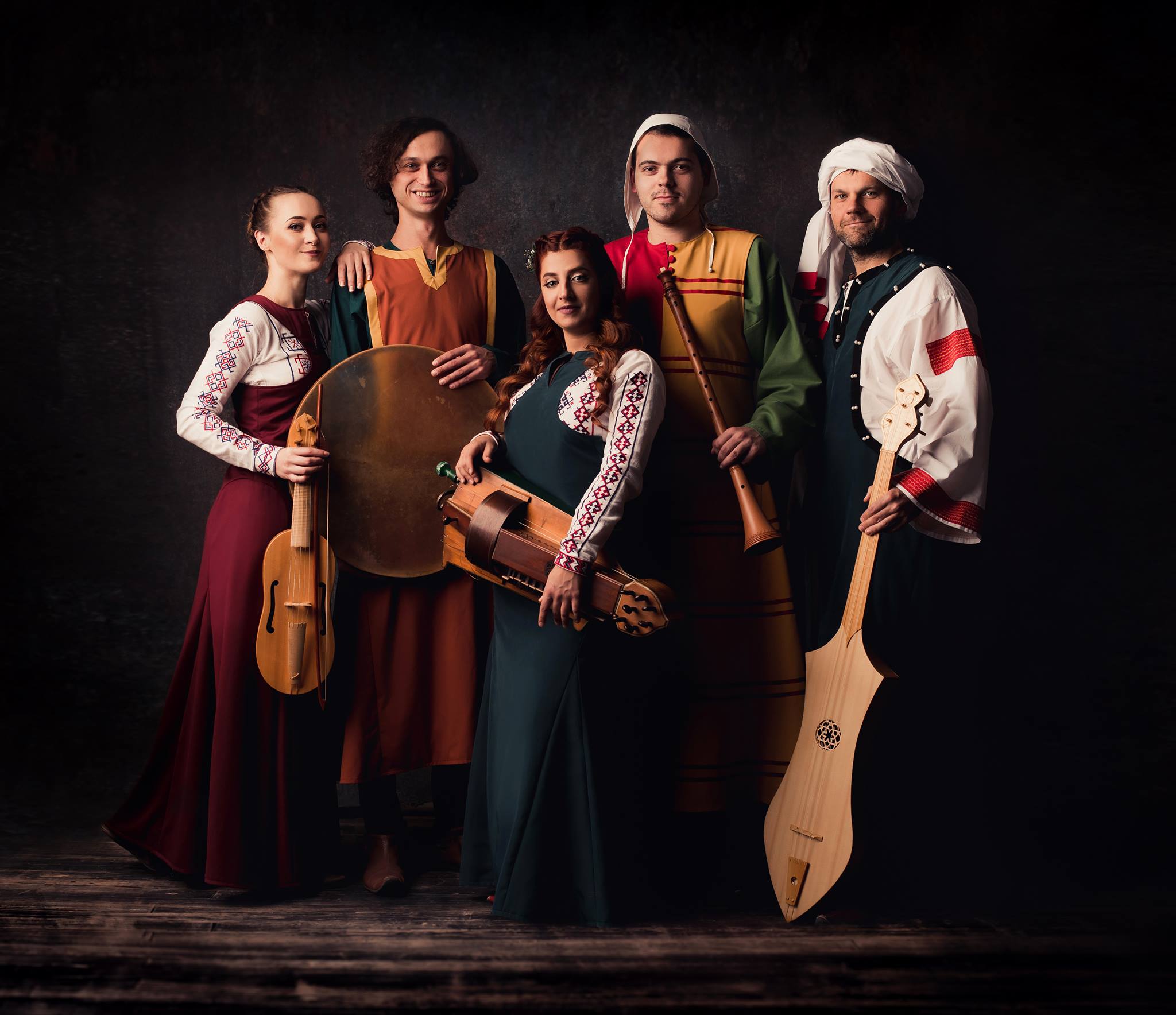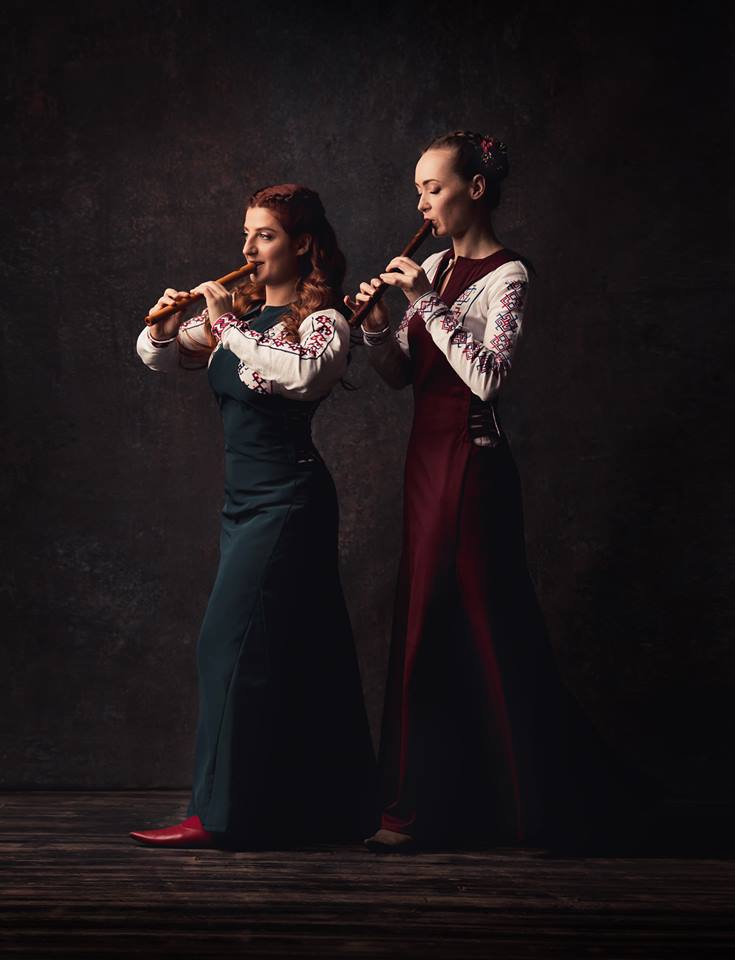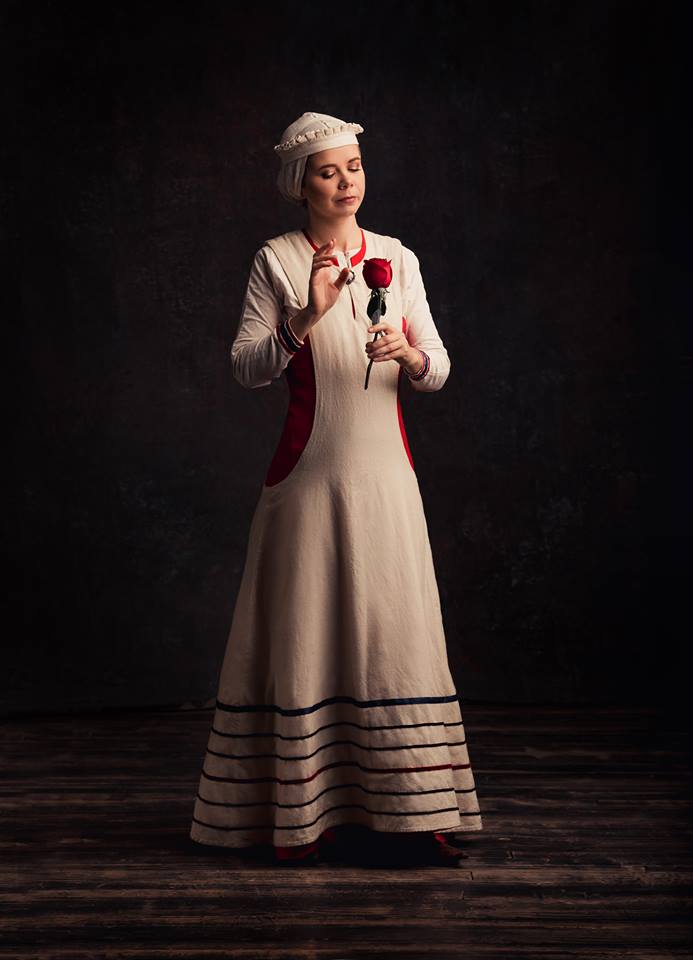
kings-and-beggars.com.ua
bandcamp.com
spotify.com
© 2018 Kings and Beggars
Rosa das Rosas / Kings and Beggars

kings-and-beggars.com.ua
bandcamp.com
spotify.com
© 2018 Kings and Beggars
 |
1. Como poden per sas culpas [4:10]
CSM 166 2. Porque ben Santa Maria [5:11] CSM 327 3. Pode por Santa Maria [5:31] CSM 163 4. Non sofre Santa Maria [5:37] CSM 159 5. Des oge mais quer' eu trobar [1:55] CSM 1 6. Quen a omagen da Virgen [3:29] CSM 353 7. A Virgen Santa Marķa [6:03] CSM 8 8. Maravillosos e piadosos [3:46] CSM 139 9. Santa Maria strela do dia [2:55] CSM 100 10. Miragres fremosos [4:01] CSM 37 11. Como Deus fez vinno d'agua [4:59] CSM 23 12. A que por [5:57] CSM 384 13. A Madre de Jesu-Cristo [1:55] CSM 302 14. Da que Deus mamou [3:43] CSM 77 15. A Virgen mui groriosa [6:17] CSM 42 16. Quen quer que na Virgen fia [5:39] CSM 167 17. Rosa das rosas [5:36] CSM 10 |
XIII century Castilian court was known as a science and art centre from Pyrenees to the Alps.
Musicians, dancers and singers drove to the court of Alfonso X the Wise,
and not only Christians but also people of other believes.
We want to show this educated multicultural society of those old times.

Kings and Beggars
Anna Vasylchenko — medieval fiddle, recorders, litvinian shawm, galician gaita, vocals
Yevhen Grinevich — recorders, medieval shawm, vocals
Marta Hovdysh — hurdy-gurdy, recorders, vocals
Max Kerner — bass citole, oud, vocals
Artur Temchenko — medieval drum, tar, daf, pandereta, percussion, vocals
Guest musician: Anton Korolev — tarota
Recorded, mixed and mastered by Max Kerner at MAX220 Studio, Lviv, 2016-2018
Sound engineering: Max Kerner and Anna Vasylchenko
Designed by Artem Bulat, Anna Kozlovska and Anna Vasylchenko
Photos by Arina Kozlovska
youtube.com:
"Rosa das Rosas"
Full medieval show
Thanks
Kings & Beggars thanks Dmytro Pliska and Kateryna Uspenska for help in selling our albums!
Anna thanks all members of Kings & Beggars for pieces of
individuality they have put in this work!
Also thanks to Artem Bulat
for as always invaluable input in the life of the ensemble and
comprehensive support :)
Max thanks to Lusiena for inspiration and cosiness, my sweethearts
Valery, Ksu and Mikefor joy,
my dear mother for patience and caring and
everyone from K&B for pleasant work and providing me with cheese
during mixing and mastering process.
Eugen thanks all in Kings & Beggars for their existence in this world :)
Marta: Sincere thanks to all members of the band for all the jokes,
funny moments and fantastic creative atmosfere. Thank you for taking me
into the family and kindly having endless patience for me being an
annoying perfectionist. Seriously, guys, you're the best.

The Cantigas de Santa Maria (CSM), composed at thee court of king
Alfonso X of Castile in the second half of the XIII century, is a vast
repertory of poetry in medieval galician. The 420 compositions include
353 narratives of miracles of the blessed Virgin Mary as well as a
large number of devotional and liturgical poems, almost all set to
music, and many illustrated by miniatures divided into smaller panels.
The CSM are thus more than a body of literature or a miracle
collection, they are a cultural project of great importance for
medieval literature, music, and art, and for the history of patronage.
Alfonso X's 'Cantigas Project' occupied most of his reign (1252-1284)
and was seen by him as an important part of both his political survival
and his personal salvation.
In his last will and testament of 21 january 1284, written in Seville,
seventy-four days before his death, Alfonso X decreed that all the
cantigas codices be housed in the cathedral of that city, where his
body was to be interred and that the cantigas de loor should be sung in
the cathedral on the feast days of the Virgin. According to
José. M. Llorens Cisteró, the king's wish was honored on
feast days, not only in the cathedral, during the procession, but also
in religious ceremonies at court and in popular festivities.
By the middle of the fourteenth century, however, interest in the
cantigas had begun to decline until they were totally forgotten.
Four contemporary manuscripts survive: To (the Toledo ms, now in the
Biblioteca Nacional de Madrid), T (the Códice Rico, in The
Escorial Library), E (the Códice de los Músicos, also in
The Escorial) and F (the Florence ms, in the Biblioteca Nazionale
Centrale, Florence). They represent at least three different
compilations or stages in the elaboration of the Cantigas Project: an
early collection of 100 poems to which appendices were added (To);
followed by a much expanded and highly ornamental collection of 400
(T+F) of which the second volume (F) was left in an incomplete and
possibly disordered state; and a reference collection of 400 (E) with
many imperfections and signs of hasty completion.

Como poden per sas culpas (CSM
#166) - Because of his sins, a man suffered an illness that twisted his
lambs and left him crippled. He stayed that way for five years. He
vowed that if he were cured he would take a quantity of wax to Salas
every year. He was immediately cured. Without delay, he went to Salas
with the wax. Although he had not walked for a long time, he was nimble
and felt no pain. He thanked and praised Mary for the miracle.
Porque ben Santa Maria (CSM
#327) - A church dedicated to the Virgin stood outside the town of
Odemira. 1t was a venerable church and many miracles were performed
there. A woman offered to the church a finely woven altar cloth. It
measured a little more than a vara, a priest admired the cloth and
coveted it. He stole it and took it to his house. He had a pair of
underpants fashioned from it. He put on his new underwear and lay down,
but he could not sleep because his heels began to press into his
thighs. The pain was excruciating, and, confessing his sin, he called
on the Virgin. He repented and had a large linen cloth placed on the
altar. He was taken to the church and everyone prayed for him to the
Virgin. She cured him and they praised her name.
Pode por Santa Maria (CSM #163)
- A gambler, playing dice in Huesca, lost everything and renounced the
Virgin. He was instantly crippled and struck dumb. He could not move
from that place, and if he wanted something he had to gesture for it,
using sign language, he asked to be taken to Salas. At Salas, he gazed
at the Virgin's statue and asked her pardon. The Virgin healed him and
he praised her from then on.
Non sofre Santa Maria (CSM
#159) - Some pilgrims took lodging at an inn and ordered bread, wine
and meat for dinner. Then they went to the church to pray. A servant
girl stole one of the nine pieces of meat. On their return, the
pilgrims discovered that the meat was missing and asked the Virgin to
recover it. The piece of meat jumped up and down, striking the sides of
the chest in which it was hidden, the pilgrims rejoiced, recovered the
meat, and hung it from a silk cord in front of the Virgin's altar at
Rocamadour.
Des oge mais quer eu trobar (CSM #1) - Cantiga de loor, instrumental
Quen a omagen da Virgen (CSM #353) — instrumental
 A Virgen Santa Maria (CSM #8) -
A minstrel, Pedro de Sigrar, was singing and playing fiddle in front of
a statue of the Virgin. He prayed to the Virgin to give him a candle
and she caused one to rest on his fiddle. A monk, the shrine treasurer,
snatched it back, and accused the minstrel of sorcery. The candle
returned to the fiddle and the people, seeing this, did not allow the
monk to take it away from the minstrel again. The monk acknowledged the
miracle, repented, and asked the minstrel's pardon. Every year the
minstrel brought a candle to the Virgin's church.
A Virgen Santa Maria (CSM #8) -
A minstrel, Pedro de Sigrar, was singing and playing fiddle in front of
a statue of the Virgin. He prayed to the Virgin to give him a candle
and she caused one to rest on his fiddle. A monk, the shrine treasurer,
snatched it back, and accused the minstrel of sorcery. The candle
returned to the fiddle and the people, seeing this, did not allow the
monk to take it away from the minstrel again. The monk acknowledged the
miracle, repented, and asked the minstrel's pardon. Every year the
minstrel brought a candle to the Virgin's church.
Maravillosos e piadosos (CSM
#139) - A woman took her son to church and commended him to the Virgin
so that he would be kept safe from harm. The little boy, who was eating
a piece of bread, ran up to the statue of the Virgin and Child. He
offered the bread to the child, saying: "Do you want a bite?" the
Virgin told her son to invite the little boy to dine with him in
heaven. The infant Christ spoke to the boy, promising him he would eat
with him in heaven the following day. The little boy died. He went
straight to heaven.
Santa Maria strela do dia (CSM #100) cantiga de loor, instrumental
Miragres fremosos (CSM #37) - a
man felt a burning sensation in his foot and lay before the altar in a
church dedicated to the Virgin. The pain was so intense that he had his
foot amputated. Nevertheless, he continued to pray to the Virgin to
perform a miracle on his behalf. While he was sleeping, the Virgin
stroked his foot and healed the flesh. When he woke up he examined his
foot. After discovering that it had been restored, he began to walk
around. Everyone who heard the news came to see it and gave thanks to
the Virgin. They held her miracles to be more glorious than those of
any other saint.
Como Deus fez vinno d'agua (CSM
#23) - The Virgin saved a lady of good character from embarrassment. A
king happened to visit her and she gave him meat, fish, bread, and
barley, but she had very little wine. She tried to buy some wine, but
could not obtain any. She went to a church and prayed to the Virgin,
vowing never to wear wool or linen again. Her prayer was answered. The
king and his companions had plenty to drink and both rich and poor
found plenty of wine in the woman's cellar.
A que por (CSM #384) - There
was a monk, an ordained priest who delighted in saying the hours of the
Virgin and reading the lives of the holy fathers. He also wrote very
beautifully, whenever he came to write Mary's name, he painted it in
three colors: gold, blue and rose. The monk carried Mary's name with
him and kissed it frequently to overcome the devil. Once, he fell
gravely ill. The abbot and all of the monks gathered around him. One
was appointed to stay at his side, since he was in such a terrible
condition. The appointed friar fell asleep and saw the Virgin Mary
appearing at the sick monk's bedside. She told him not to be afraid and
promised to take him to Paradise. She said that his name was written in
the Book of Life because he had written hers in three colors. Then the
Virgin took the sick monk's soul. When the friar discovered that the
sick man had died, he rang the bells. The monks and the abbot came
quickly and he told them about the miracle. The monks praised the
Virgin and the abbot had the miracle put in writing.
A madre de Jesú-Cristo (CSM #302) - instrumental
Da que Deus mamou (CSM_ #77) -
A woman was almost entirely paralyzed. Her limbs were shriveled and
twisted, and no medicine could cure her. She was carried on a litter to
the church of the Virgin in Lugo and kept vigil there. On the Virgin's
feast in august, mary straightened her limbs. Each of her limbs made a
loud cracking sound as the shrunken tendons stretched. The bishop and
the people who witnessed her healing wept and gave thanks to the Virgin.
A Virgen mui groriosa (CSM
#163) - During tile renovation of a church in Germany, a statue of the
Virgin was moved temporarily from the altar to a portico in the town
square. Some young men were playing ball in the square. One of the
youths was wearing a ring given to him by his beloved. Thinking the
ball could damage it, he put it on the finger of the statue for
safekeeping. Kneeling before the statue, he placed the ring on its
finger. He promised the Virgin that he would never love another lady,
and that he would be faithful to her. The statue closed its finger
around the ring, and the people seeing this, advised the young man to
join the cistercian order. He disregarded his promise to the Virgin and
married his girlfriend. On his wedding night, as he was lying in bed,
the Virgin appeared to him and rebuked him for being unfaithful to her.
The bridegroom would not leave his bride, so the Virgin lay down on the
bed, and separated him from his wife. She demanded that he leave at
once. He was so frightened that he got up at once, and wandered through
the wilderness for a month. Later, he lived as a hermit in a grove of
pine trees and served the Virgin.
Quen quer que na Virgen fía
(CSM #167) - A moorish woman from Borja had a beautiful son. The boy
became ill and died. His mother had heard of the miracles performed by
the Virgin of Salas and she decided to trust in her. Despite the
objections of other moorish women, she commended her son to the Virgin
and bought a wax image to offer at Salas. She went to Salas, carrying
her dead son. She prayed to the Virgin, keeping vigil all night long.
The Virgin revived the child although he had been dead for three days.
The woman converted to Christianity.
Rosa das rosas (CSM #10) - cantiga de loor
